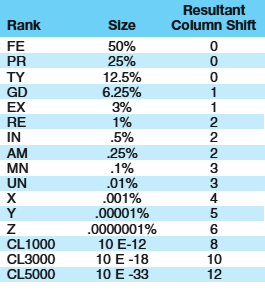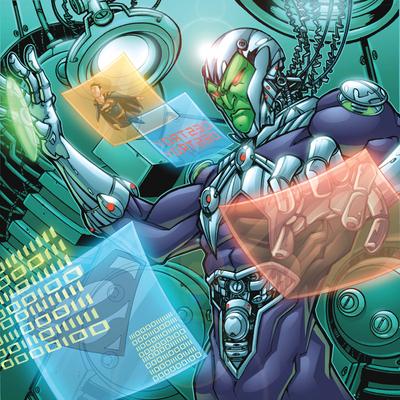Age-Shift
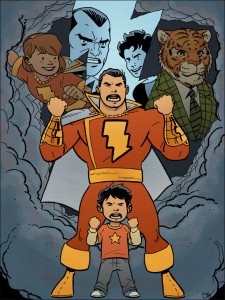
One word is all it takes to push little Billy past puberty.
The hero can alter his apparent age at will, His body and physiology change to simulate any age, younger or older. Mental facilities remain unaffected. When creating the hero, the player can opt to link the hero’s other physical Powers to a different physical age.
Rank determines the apparent number of years the hero can Age-Shift. Normally, a character cannot voluntarily Age-Shift to an age younger than a newborn, since this is definitely suicidal. This barrier can be passed of the hero’s Power is being controlled by an outside force.
Source: Ultimate Powers Book
Alter Ego
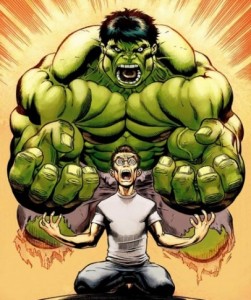
You wouldn’t like him when he is angry.
The hero has two different forms. One is a normal, powerless being; the other is the powerful, heroic self.
When creating the hero, the player has to create two different beings. The statistics for the primary self should be fairly routine (all physical abilities ranging from Feeble to Good). All bets are off for the heroic self. Something many people never consider is that the heroic self might be a relatively normal human, while the normal self is something a little lower on the evolutionary ladder.
The two selves never co-exist except under extraordinary circumstances. Possible causes of simultaneous existence include time warps, cloning, and Lifeform Creation. The two selves may even be separated for an extended time, such as what happened to Bruce Banner and the Hulk.
The primary drawback to this Power is the uncontrolled reversion to the normal self, especially when it occurs during dire circumstances. For example, Mightyman is rescuing a sub from the ocean floor when he reverts to his other self, little Eddy Edwards. (“Can you say ‘fish food?’ Sure you can.”) Variations include automatic or voluntary transformation, duration, and shared minds versus semi-independent mentalities.
Source: Ultimate Powers Book
Anatomical Separation
This is the most grotesque Power available but it has its advantages nevertheless. With this Power the hero can spontaneously and harmlessly separate his body into independently functioning segments. Physiological functions like blood flow and neural activity continue in the same manner as if the body were whole. Detached parts cannot regenerate if the – body is destroyed unless the hero has a regenerative Power. If any detached part JS: damaged or destroyed, the hero suffers the normal damage; his body also reassembles immediately, if possible.
The practical basis for this is the power of Gateway/Space-warp targeted on the hero’s own body. In “game reality” the hero forms two parallel Space-warps at the desired point of detachment, then shifts the location of the outer warp. The perceived result is that part of the hero’s body detaches and flies off on its own.
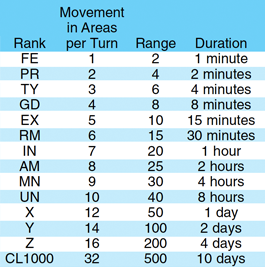 Normally, the majority of the hero’s body acts as an anchor and cannot be moved by shifting the Space-warps. The hero can develop Power stunts with which he can transport himself. (Example: the hero sends out a hand to grab onto a distant object and then pulls himself to it.) Detached segments can travel at Power rank speed for Land/Water movement; involuntary reattachment due to injury is instantaneous. The maximum range and duration of detachment are also based on the Power rank. Each additional detachment decreases the range and duration by -1CS, for a cumulative effect. If a single detached segment is prevented from returning to the body at the end of the duration, the rest of the hero’s body is instantly drawn to the missing piece. Any intervening barrier is destroyed, doing damage to the hero appropriate to the barrier.
Normally, the majority of the hero’s body acts as an anchor and cannot be moved by shifting the Space-warps. The hero can develop Power stunts with which he can transport himself. (Example: the hero sends out a hand to grab onto a distant object and then pulls himself to it.) Detached segments can travel at Power rank speed for Land/Water movement; involuntary reattachment due to injury is instantaneous. The maximum range and duration of detachment are also based on the Power rank. Each additional detachment decreases the range and duration by -1CS, for a cumulative effect. If a single detached segment is prevented from returning to the body at the end of the duration, the rest of the hero’s body is instantly drawn to the missing piece. Any intervening barrier is destroyed, doing damage to the hero appropriate to the barrier.
If there are two or more missing parts, the rest of the hero’s body is instantly drawn to a point midway between them. From there he can move freely in order to recover himself. He loses 1 point of Health for each 10 turns he remains apart. Upon reattaching the next-to-last part, he is instantly drawn to the last part.
Separating the legs from the torso does not cause the hero to fall. Rather, the torso can move freely about on its own, at normal movements rates for Land/Water.
Despite a player’s misgivings, this Power lends itself to several useful Power stunts. A self-propelled sword-arm is handy in a fight. A hero facing a toxic cloud could leave his nose behind. The Power provides +1CS protection against edged weapon attacks; a blade cannot sever something already detached. It is also a great Power for a macabre sense of humor.
Due to the nature of this Power, the hero has a special vulnerability to attacks that disrupt his own Space-warp. These include Gateway, Dimension Travel, any of the Teleportation forms, and any Power-affecting Powers (+2CS for the attacker).
Source: Ultimate Powers Book
Animal Transformation-Self
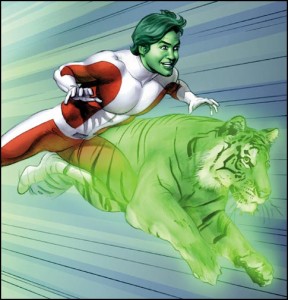
Beast Boy a.k.a. The Changeling, DC Comics
The character can alter his form into that of any animal he can think of, gaining the abilities of whatever animal form he has chosen. Although not restricted to a size limit, the smaller the animal, the longer he is able to keep the shape. The greater the animal’s mass the shorter time he can hold that form. Duration ranges from one minute to indefinite. Normal animals take a Typical Intensity FEAT, aliens a Excellent Intensity FEAT, and magical creatures need an Unearthly Intensity FEAT. When transformed he/she has the physical attributes (FASE) of the animal, but retains the mental attributes (RIP) of his original form.
Sample Forms:
Bear
Fighting: Am Agility: Gd
Strength: In Endurance: In
Edged attack damage with teeth and claws as well as Grappling attacks (+1CS). They move 2 areas/round at top speed.
Bison
Fighting: Gd Agility: Gd
Strength: In Endurance: In
Can stampede (those in the way
take a Charging attack of +3CS Strength and Endurance to hit).
Dog
Fighting: Rm Agility: Ex
Strength: Ty Endurance: Ty
Edged attack damage, move 2 areas/turn, and track with Remarkable ability.
Eagle
Eagles inflict Edged attack damage, and fly up to 4 areas/round, at top speed.
Elephant
Fighting: Gd Agility: Ty
Strength: Am Endurance: Am
They move 1 area/turn, and can inflict either Blunt or (if they have tusks) Edged damage.
Snake, Poisonous
Their bite (Edged attack, no Stuns or Kills) carries a deadly venom (Good Intensity poison).
Wolf
Fighting: Am Agility: Rm
Strength: Ex Endurance: Ex
Edged attack damage, move 2 areas/turn, and track with Remarkable ability.
Source: Ultimate Powers Book/Player’s Handbook/Devcross edit
Animal Mimicry
 This is a form of Power Duplication. The hero can duplicate the natural abilities of any animal. The hero’s body does not significantly change; instead, existing flesh changes the way it functions. For instance, perhaps the lungs can now breathe water. The rank determines a successful duplication. Normal animals take a Typical Intensity FEAT, aliens a Good Intensity FEAT, and magical creatures need an Unearthly Intensity FEAT. Should the hero wish to duplicate an imaginary animal or being, he must make a Class 1000 Intensity FEAT. Duration ranges from one minute to indefinite.
This is a form of Power Duplication. The hero can duplicate the natural abilities of any animal. The hero’s body does not significantly change; instead, existing flesh changes the way it functions. For instance, perhaps the lungs can now breathe water. The rank determines a successful duplication. Normal animals take a Typical Intensity FEAT, aliens a Good Intensity FEAT, and magical creatures need an Unearthly Intensity FEAT. Should the hero wish to duplicate an imaginary animal or being, he must make a Class 1000 Intensity FEAT. Duration ranges from one minute to indefinite.
Source: Ultimate Powers Book
Blending
The hero has the ability to match his color exactly to his surroundings. This Power functions as a practical invisibility. The body’s outline and contours are still detectable if the observer is very careful. The Power is most effective if the hero is in low light or at a distance from the viewer. Variables include speed and complexity of color change, and whether the Power is automatic or voluntary.
Source: Ultimate Powers Book
Body Adaptation
This is related to Life Support. The hero’s body automatically adapts its physiology to enable it to survive in hostile environments. Unlike many of the other Powers that also permit this, Body Adaptation physically changes the hero’s body. This Power involves automatically functioning versions of Body Transformation and Shapeshifting. The Power changes the hero into a form that has primary abilities proportional to the new environment. Example: An Adapting hero in a heavy-gravity world might now possess Monstrous Strength, but so do all the natives.
Note: If the hero possesses a Strength rank greater than Typical, that CS is carried over into the new situation. In the above example, if the hero possessed Remarkable Strength on Earth, he possesses Shift Y Strength on the heavy world. The hero can completely adapt in one to ten turns, depending on the degree of difference between the new and home environments (Judge’s discretion). The adaptation may provide the hero with new ways to move. On a water world, the hero might sprout fins.
There is only one adaptation for each type of environment, and it is triggered automatically by the hero’s entrance into the new environment. The Power cannot provide the hero with protection against hazards that suddenly occur; a prime example is the hero failing from a great height. This is a hazardous situation, but not a hazardous environment. When adaptation occurs, the hero gains the subconscious knowledge of how to use the new adaptations for survival. If not, we waste game time while the hero learns to breathe. At Shift X, the hero can consciously control the manner of adaptation.
Source: Ultimate Powers Book
Body Coating
The hero can surround himself with a flexible layer of a protective substance not normally found on his body. The body coat provides protection and allows the hero’s Power(s) to manifest (i.e., if the body coat is not present, the hero cannot use his other Powers). Damage to the body coating is not carried over to the hero’s own Health; no points are lost even when the coating is completely destroyed. Any damage to the coating can be quickly repaired by the hero’s body secreting more of the coating material. The degree of protection and the speed of repair to the coating are determined by the Power rank.
The coating can be of any one substance. When creating the hero, the player must determine the nature of the Body Coating material. Common examples include ice, iron, steel, copper, rock, wood, and insulation. Each material has its own characteristics.
If the player rolls this Power more than once when creating the hero, the player may opt for a variety of coatings or increase the rank of -the first coating by +1CS, cumulative.
When coated, the hero is vulnerable to attacks against that specific material, like flame against wood, electricity against metal, -or sudden thermal change against rock. Variables include the material strength of the coating, its normal duration, the speed of creation, the rate of replenishment, and the effects on the body.
The Body Coating Power gives the hero an added vulnerability to relevant Matter Control Powers. When the coating has reached its duration limit or is no – longer needed, it simply flakes off the hero, s body and quickly disperses as dust or vapor.
If an opponent has the ability to negate the coating’s flexibility (through Matter Control, Power Control, or Magic), the hero is paralyzed until he can remove the coating or until it reaches its duration.
Source: Ultimate Powers Book
Body Transformation
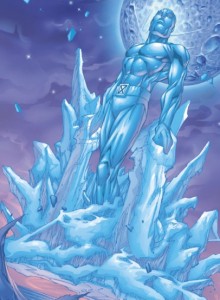 The hero can alter the nature of elements and compounds within his own body. Innate safeguards in this Power maintain the hero’s lifeforce in any altered state. Altered states may not necessarily be mobile, or may move in new ways. (At FE and PR ranks, the hero is immobile.)
The hero can alter the nature of elements and compounds within his own body. Innate safeguards in this Power maintain the hero’s lifeforce in any altered state. Altered states may not necessarily be mobile, or may move in new ways. (At FE and PR ranks, the hero is immobile.)
Note: The safeguards that protect the hero might be disrupted or not included if another hero tries to duplicate this Power. In such cases, use of this Power may be instantly fatal! While in an altered state, the hero has a special vulnerability to attacks menacing that form. If the Absorbing Man transformed himself into paper while fighting the Human Torch…
While in a solid altered state, the hero retains his overall normal appearance. If liquid or gaseous, he can assume any shape and still reform into his original appearance at the cessation of the Power.
Normally, the hero must transform his entire body into the desired material. He can transform himself into multiple materials or transform specific parts of himself at a cost of -1CS.
Source: Ultimate Powers Book
Bouncing Ball
This is a specialized form of Shapeshifting. The hero can transform his body into a resilient sphere, apparently transforming his body into a balloon-like caricature of himself. Heroes with this power are rarely taken seriously, but—despite the image problem—this power offers substantial benefits to the hero. While he is inflated, the bouncer can travel at power rank speed. His Fighting rank is increased by this power’s rank number. He has +3CS resistance to blunt physical attacks. On the down side, he also has a -2CS resistance to slashing attacks. In a given situation, the bouncer can maintain this power for the number of turns up to his power rank number before he has to deflate and rest. After 10 turns, he can then reinflate himself.
Source: Ultimate Powers Book
Chemical Mimicry
This is related to both Body Transformation – Self. The hero can duplicate the chemical properties of any element or compound without his own body actually changing in composition. The hero’s flesh simply acts as if it were the desired substance.
Obviously the hero retains his solidity, even when duplicating the properties of a liquid or gas. Depending on the desired effect, the range of his chemical power varies from contact to one area.
Tracking the hero by smell is difficult because his scent changes with each mimicry (-4CS to tracking ability).
Source: Ultimate Powers Book
Density Manipulation – Self
The hero with this Power can alter his mass at will. Density may range from Shift 0 (almost intangible) to the Power rank of the Ability. The hero who has altered mass weighs as much as a character with that strength could lift. (A hero with Feeble Density would weigh 50 Ibs, while one with Shift 0 would be effectively weightless).
An individual gains Body Armor equal to his current Power rank. In addition, the character may inflict charging damage using the Power rank instead of the Strength ability, and may affect materials of lesser material strength than the current Power rank. in the Shift 0 state the hero may not initially pass through solid items (Phasing), but is immune to physical attacks (though not energy or force attacks).
A high density may slow the character down. If the density of the character is higher than the individual’s Endurance, both Fighting and Agility suffer a -1CS penalty.
One Power Stunt developed by density manipulators is to solidify inside a target. Those heroes with Density Manipulation may not do so initially, but may develop the ability as time goes by. Solidifying inside a non-living object will result in possible damage to the object. Treat the character’s Power rank as Strength to determine the FEAT needed (if any) against the material strength. Disrupting the material will result in damage to the hero equal to the material strength of the target.
This Power Stunt may also be applied against living targets. In this case, make a FEAT against the Endurance of the target. If the target makes a successful FEAT, no damage is inflicted. If the target fails, the target takes damage equal to the Power rank and must make a second Endurance FEAT to avoid losing consciousness.
Source: Ultimate Powers Book
Elongation
This is a specialized form of Shapeshifting. The hero can temporarily increase the length of any part or his body without losing leverage or strength. The hero can elongate any single part a maximum number of yards equal to his power rank number. If two or more parts are elongated, this limit is the total combined length for all parts concerned. The hand counts as part of the arm unless the hero is specifically elongating his fingers; in this case, the maximum is divided by the number of fingers elongated. For example, Mr. Fantastic is usually shown elongating an arm with a normal hand at the end of it; this gives him a greater reach than if he elongated his hand instead. The hero can maintain any single act of Elongation for a number of turns up to his power rank number.
This power is primarily used by heroes like Mr. Fantastic to extend their reach or stride. Other heroes might also use the power to elongate body parts like the nose, ears, or eyes. This useful, albeit grotesque, tactic enables the hero to use his nose as a snorkel, his eyes as periscopes, and to eavesdrop on a room several floors away by sending his ear through the ceiling vent.
The character with this Power may attack non-adjacent foes in close combat types of attacks (slugfest, grappling, etc.). The target of these attacks may only make close attacks against the part of the opponent that is attacking, and as such may not benefit from Kill, Stun, and Slam results.
Source: Ultimate Powers Book
Energy Body
The hero can transform his body into a coherent energy field that supports his lifeforce and is capable of controlled actions. The energy can be of any type (see the Energy Emission listings).
When creating the character, the player determines the nature of the energy into which the hero can turn. The rank determines the number of possible energy types. The rank for each energy type is originally Good; this is modified by the Ability Modifier Table found on page 6 of the Player’s Book. Each Power is rolled separately. Thus, a hero might have a Poor sound-form and an Incredible radiation-form. Damage to the Energy Body is the same as damage to the normal body. The Energy Body is subject to anything that would affect energy of its type. The hero makes a standard Resistance roll to determine such effects on the Energy Body. The hero may find himself confined in a storage field while in energy-form. If so, he must make a red FEAT to attempt to revert to normal. If he fails, he must escape in his energy form.
The Energy Body is a relatively unlimited supply of that particular energy type. The hero can expend great amounts of it and still be able to return to normal. Completely depleting the Energy Body requires a red FEAT rolled by the Judge or an adversary. The hero can also ab s orb existing energy of his chosen type to replenish himself.
This Power includes the relevant form of Energy Control and Emission for the purpose of controlling the energy within the body.
Source: Ultimate Powers Book
Energy Sheath
The hero can surround himself with an energy field. This field provides protection, life support, and a means of manifesting the hero’s other Powers. The energy field can be of any type (see the Energy Emis sion section for available types). Each energy field has its own characteristics that affect the ways the hero can use the Power.
Only one Energy Sheath can be used at a time. The hero may possess several possible Energy Sheathes. The original rank for each is Good; this can be modified by the Ability Modifier Table on page 6 in the Player’s Book. Each Power is rolled separately. Thus a hero might possess a Poor Sonic Sheath and an Incredible Vibration Sheath.
Damage to the Sheath does not affect the hero’s Health. If the Sheath is destroyed, the hero. must make a red FEAT to regain it. Possible ways of destroying a Sheath include Energy Control and Conversion, Power Control, and Magic. When the hero is using this Power, he has a special vulnerability to Energy Control and Conversion Powers that can affect his type of Energy Sheath (-2CS). However, he also has +2CS Resistance to attacks using the same energy form as his Sheath. For the duration of the Sheath, it is assumed to be made of an infinite supply of that energy. (Otherwise, the character bookkeeping would be a nightmare. “Let’s see, if I throw a fireball, that’s gonna cost five minutes of power…”)
When creating the hero, the player can opt to replace one of the other Powers with a Transportation Power. The player can also replace other Powers with the appropriate Energy Emission and Control Powers, if he so chooses.
Source: Ultimate Powers Book
Evolution
The hero can alter his mind and body to simulate any stage of the evolutionary path of his species. Note: This is “comic book” evolution, folks, the kind where superstrong cavemen eventually evolve into giant brains with vestigial limbs. If the hero possesses other Powers, the player may divide them among different evolutionary stages. For example, the caveman gets the physical Powers while the giant brain gets the mental ones.
Rank determines the duration of the assumed stages.
For the caveman, drop the Reason, Intuition, and Psyche, but raise the Fighting, Agility, Strength, and Endurance. For the giant brain, reverse the process and raise the Reason, Intuition, and ‘ Psyche. In both cases, the decreased abilities drop to Feeble, while the other abilities are raised a corresponding number of ranks. Divide the ranks as evenly as possible.
Each stage also has intrinsic advantages. The caveman possesses Typical Tracking, while the giant brain possesses Typical Telekinesis and True Flight.
Source: Ultimate Powers Book
Growth
 This is a self-directed form of Enlargement. The hero can temporarily increase his physical size at will. As he grows, the hero becomes an easier target. The bonuses to be hit are not cumulative. There are three ways the power can be attained: Atomic Dispersal, Atomic Gain, and Atomic Growth. The player randomly determines the method when he creates the character or when the character first gains this power.
This is a self-directed form of Enlargement. The hero can temporarily increase his physical size at will. As he grows, the hero becomes an easier target. The bonuses to be hit are not cumulative. There are three ways the power can be attained: Atomic Dispersal, Atomic Gain, and Atomic Growth. The player randomly determines the method when he creates the character or when the character first gains this power.
With Atomic Dispersal, the hero increases the distance between his own atoms, thus increasing his overall size. His mass remains the same no matter how large he becomes. The hero also becomes increasingly fragile; his body’s material strength decreases -1CS with each doubling in size. At Shift X rank, the body becomes less dense than air. At CL1000 rank, the hero becomes intangible and can Phase through normal matter.
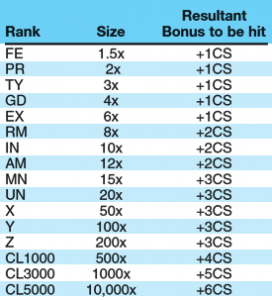
The table details to-hit bonuses against Growth-using characters.
Atomic Gain enables the hero to somehow create or gain new atoms and incorporate them into his atomic structure. As the hero gains new matter, his size and mass increase as well. As the hero grows, his strength increases +1CS for each +2CS of growth. The hero’s Primary and Secondary abilities are unaffected. However, Health seems to increase because physical attacks do less relative damage. Bullets, for example, would be nothing more than grains of high-velocity sand to a giant hero. Note that when the hero returns to his original size, wounds decrease in size—but imbedded bullets and other objects do not!
Atomic Growth enables the hero to increase the size of his own atoms, thus increasing his overall size and mass. The hero’s strength increases only enough to enable him to move his own body; lifting strength does not increase. This form of Growth has a dangerous side effect. As the hero’s atoms grow, they are unable to interact with normal atoms. The hero is unable to breathe, drink, or eat normal matter. Fortunately, there is a 95% chance (determined at the time the hero is created) that the power envelops the hero’s body in a field that temporarily increases the size of consumed matter. Note that this is the only form of growth that will enable the hero to travel into macroverses or, if the hero is originally from a microverse, enable the hero to reach our own universe.
Source: Ultimate Powers Book
Imitation
Face Changer:The hero can change his superficial appearance but cannot alter his basic form or dimensions. The hero has conscious control over the movement and placement of muscles, cartilage, and minor bones (nose, fingers, cheeks) and can alter the color and appearance of his skin and hair.
The hero can use this Power to assume any human appearance, provided the desired shape roughly matches his own.
Human Changeling: The hero can alter his appearance, form, and dimensions to appear in any desired human or humanoid shape. The hero may either imitate a known being or assume a created appearance.
This Power does not allow the hero to imitate Powers, Talents, or mannerisms.
Invisibility
With this Power a hero can render himself undetectable by normal, consciously willed sight. There are four very different means of accomplishing this effect. Each form has unique characteristics regarding such factors as the area made invisible, protection against light-based attacks, mechanical detection, and detection by other means.
Physics: This is the form possessed by Sue Richards. The hero’s body is totally transparent to the visible light spectrum. He cannot be mechanically detected or recorded (i.e. by photography or television) and is immune to attacks using visible light (lasers, mostly). At Good rank and higher, the invisibility range can be extended to cover other sections of the energy spectrum (infrared and ultraviolet light, radiowaves, hard radiation); this also bestows immunity to attacks using these forms. At these levels the hero can also extend the area of invisibility beyond his body. This permits the hero to protect others and, more importantly, to wear clothing. (H.G. Wells’ Invisible Man was unable to even conceal undigested food within his body.)
Telepathic: The hero is actually visible but is ignored and immediately forgotten by beings who would otherwise be capable of detecting his presence. He is also immune to detection by other senses. (“Did you hear anything? Nah.”) He can be mechanically detected and recorded (this is where this Power gets weird); a video monitor or alarm that reveals the hero’s presence will be ignored by anyone within range of the hero’s Power. Photographic film records the hero, but anyone looking at it while within range of the hero’s Power will ignore the hero’s image. Anyone outside this range can see the hero quite clearly, and will be very confused about the lack of reaction by those around the hero. He can extend this invisibility to anyone in physical contact with him. If the hero loses touch (literally) with someone whom he was protecting in this way, that person is immediately susceptible to the Power’s effect and forgets that the hero was ever there. Robots and cybernetic beings are unaffected by this Power, but they can be protected by it. The Power does not affect any light-based attack but does provide protection against psionic attacks (-2CS for the attacker).
Hallucinatory: The hero is actually visible but is surrounded by a telepathic field that makes others see an empty spot where the hero is. The Hallucination can incorporate the hero’s surroundings and affect real-time viewers at a great distance. In other words, the hero can disguise the area around himself and this disguise will fool anyone looking at the area, even if they are miles away. However, this Power doesn’t fool film or videotape; these record the scene as it really is.
Hallucination also prevents detection by other senses. The hero can be mechanically detected and recorded; as with the Telepathic form, anyone within, range o f the effect ignores the hero. Robots and cybernetic beings can also detect him. This Power provides no protection against light-based attacks, but does provide protection against psionic attacks (-2CS for the attacker).
Holographic: The hero is actually visible but has surrounded himself with a holographic image of empty space. The holograph can incorporate a wide area and affects anyone within line of sight (if someone can see across interstellar space, the holograph fools you). The holograph can be mechanically detected and recorded as if it were real. It will not prevent detection by other senses. Robots and cybernetic life accept the holograph as real. It provides protection against light-based attacks equal to his Power rank -2CS. (Example: the Incredible rank provides Excellent Resistance.)
The duration of any form of Invisibility is a function of the Power rank. This Power can be reduced in effectiveness or even terminated by certain acts, performed either by the hero or someone under the Power’s effect. Simple physical contact can alert others to the hero’s presence (Physics, Hallucinatory, Holographic). Physical attacks by the hero terminate the Invisibility (Telepathic) or reduce its protection by -1CS for each attack the hero makes (all other forms). A Invisible hero may find himself surrounded by a coating material (rain, dust, and paint for example). This only effects the Physics-based Invisibility. At Feeble, Poor, and Typical ranks the hero is visible for the duration of the coating. At Good or higher ranks, such coatings remain visible for the number of turns equal to eight minus the number of Power rank levels. (Example: Invisible Woman is struck by a balloon filled with paint. Her Power is Excellent and renders the paint invisible in three turns.)
There is a base 2% chance that the Invisibility is permanent (4% if the hero is alien). Such a state can only be negated by nullifying the Power itself, permanently. Previously controllable Invisibility can be made permanent through brain damage or Powers that affect the hero’s control.
Source: Ultimate Powers Book
Mass Alteration
Mass Decrease: The hero can diminish his body’s mass. His weight decreases to a percentage equal to his power rank number. For example, the Vision’s Unearthly rank in this power decreases his weight by 100%, making him completely weightless. At Shift X and higher, the hero attains buoyancy and can lift additional weight. The added weight is a percentage of his normal body weight; for example, a 160 lb. man with Shift Z rank in this power can carry an additional 800 pounds (500% of 160 lbs.). When the hero is created, the player can increase the power’s rank +1CS by making its effect permanent. The optional power is Gravity Manipulation.
Mass Increase: The hero can increase his body’s mass. His weight is multiplied by the power rank number. For example, a 98-pound weakling with Remarkable rank can increase his mass to 2,940 pounds (30 x 98). Fortunately, a side effect of this power increases the hero’s basic strength. No matter how much the hero weighs, he can still move as if he were his normal weight. Lifting strength remains the same. Of course, as the hero weighs more, he has a greater effect on the environment. At 2,940 pounds, our hero can fall through previously sound flooring or collapse the shocks on his 1973 VW Beetle. Physical force has a decreased effect on the hero because of his greater mass. In game terms, the power gives the hero power rank resistance to physical attacks. The hero can also use the power rank instead of his strength to inflict charging damage. Formerly weak characters can embarrass their adversaries with this new-found might. For example, the macho super-criminal Manbrute may flee into obscurity when Wimp-man simply sits on him with all 2,940 pounds, then delivers a stinging lecture on the benefits of niceness while the camera crews have a field day.
Source: Ultimate Powers Book
Phasing
The hero can render his body intangible to normal matter. This enables him to pass harmlessly through any object. The hero’s power rank must exceed the barrier’s material strength in order for Phasing to occur. The hero can Phase through Force Fields, Body Armors, Resistances, and Invulnerabilities of lower ranks by making a green FEAT. Because the hero is out of phase with normal matter, he cannot breathe. Thus, the practical duration limit on this power is the length of time the hero can hold his breath. If the hero has some way around this problem, the duration is unlimited. Note that if the power is somehow “turned on” permanently, as happened to Kitty Pryde, the power gains the ability to transform air into phased particles that the hero can breathe. In the Marvel Universe, Phasing has a damaging effect on delicate electronic devices. By Phasing through such devices, the hero can disrupt normal activity and scramble any on-line programming. If, during the character creation process, the player decides to forego this side effect, he can raise his hero’s power rank +1CS. For modesty’s sake, it is assumed that the power also transforms the hero’s clothing and carried possessions into phased matter. The power’s side effect automatically scrambles any electronics the hero is carrying (Kitty Pryde wears a wind-up watch, never a digital one). If the player wants to risk his hero’s modesty for the sake of a more realistic game, the player can assume either that the power only transforms whatever the hero was wearing when he first got this power (severely limiting the hero’s wardrobe) or that there is a base 70% chance that the power automatically transforms whatever the hero is wearing at the time. In either case, this must be determined when the hero is first created.
Source: Ultimate Powers Book
Physical Gestalt
This is a variation of S2/Alter Ego. Two or more relatively normal people actually merge their bodies to form a single, powerful being— the hero. When a player rolls this Power, he has to create three different characters.
The Gestalt hero may physically resemble a blending of features from each of the merged characters, or have a completely different appearance. In any case, the Gestalt hero will have a normal appearance. No two-headed, split-torsoed freak results, unless this Power is distorted in some way. Interference by such Powers as Magic or Power Control may result in the Gestalt hero forming as a freak. The hero can still revert to his normal selves, though, no matter how weird he gets (the Judge may want to require an Unearthly FEAT, though, at his discretion). Both or all normal selves are required to form the Gestalt. If one is unavailable, the Power cannot function. Damage to a normal self is carried over to the Gestalt self; for example, if one person has a whomping head cold, so will the Gestalt. However, the Gestalt hero’s superior recuperative faculties can quickly repair any such illness. The normal and Gestalt selves never co-exist except under extraordinary circumstances (see S2/Alter Ego). The Gestalt mind may be a schizoid combination of each of the normal minds, or be a completely independent mind. In the latter case, the Gestalt may have full, partial, or no knowledge of his component selves. Likewise, the normal selves may not have any idea of what their Gestalt self is up to’ Variables include whether the merger is voluntary or automatic, the duration, and the maximum difference between normal selves when attempting to merge. Normal distance is contact, but at high levels merges can occur across some distance; in these cases, the normals teleport to a common location (or perhaps one teleports to the other’s location). Duration is determined by the Psyche of the Gestalt. Time varies from one minute to indefinite, with a median of 1048 hours.
Source: Ultimate Powers Book
Plasticity
The body of the character is elastic and malleable, allowing to change of the body’s topology; that is, twist, bend, pull, stretch or otherwise distort the body’s shape into any form. The only limitation is that one cannot normally create new holes in the body. If he/she wants to assume a shape that requires holes, the character must make a red FEAT. The plasticity of the body serves as Power rank Body Armor. In addition, they may develop the following Power Stunts:
- Using the Power rank instead of Agility for catching falling items and individuals. The character with this Power takes no damage from a falling character landing on him.
- Limited imitation and disguise abilities at -2CS for detection. Plasticity will alter appearance, but not skin color or voice.
- Bouncing: similar to the Leaping Power, with the hero able to fall a number of floors equal to his Power rank number without damage, and to leap as if possessing that Power at -1CS.
Source: Ultimate Powers Book
Power Absorption
This is not the absorption of energy. but the acquiring of other individuals’ super-human Powers and abilities. Only those naturally occurring powers and abilities may be absorbed, though Robot PCs with this Power may duplicate items of technology as well. The character must touch the target in order to gain those abilities, and the target may make a Psyche or Endurance FEAT to avoid the effect. The type of FEAT is determined by the player when the character is created (that is, not on a case by case basis). The maximum of any ability so acquired is limited to the Power rank of the Power Absorption (got that?). If a Power or ability is of a higher rank (a character with Good Power rank tries to grab Thor’s Unearthly Strength). then the hero making the attempt must make a successful Psyche FEAT or be knocked out by the backlash for 1-10 rounds. and would only gain Good Strength in the process.
A character starting with this Power may only acquire one Power or ability, stated before the attack is made. If a limitation on the Power absorption is taken. a second Power may be drained. Further Powers and abilities may be added as Power Stunts. (Draining three powers or abilities at a time would have to be gained permanently before four Powers may be drained.)
While the Power-absorbing hero has the Power or ability of another, the character from whom he took it cannot use it (if the character it was stolen from had a higher rank than the Power rank of the Power thief, that ability is reduced by that amount). Characters with basic abilities reduced to below Feeble are unconscious for 1-10 rounds.
There are a number of Limitations that may be assumed with this Power including:
- Only functions on Powers
- Only functions on Talents
- Only functions on Abilities
- Takes memories as well, but if target’s Psyche is higher than the hero’s, the hero must make a Psyche FEAT to determine who controls the hero’s mind.
- Transfer may be permanent. Permanent transfer results in Karma reduced to 0, and effects of memories as noted in the above example, regardless of level of the target’s Psyche (this occurred to Rogue, with the result that in periods of stress, Carol Danvers’ personality comes to the fore).
Source: Player’s Handbbook
Prehensile Hair
This is a Power that few masculine heroes would admit to having, even if they possessed it. The Power gives the hero’s hair the capability of independent, controlled movement, as if each strand were a tiny tentacle, It is also a Power that apparently only women possess. The basis for this may be cultural rather than genetic (in the entire history of comic books, only three people had this Power—all women).
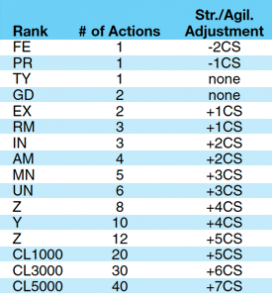
The maximum number of simultaneous actions and the Strength and Agility with which they can be accomplished are functions of the Power rank.
Using her Prehensile Hair, the heroine can perform a variety of tasks with the hairs combining to form one or more appendages. She can handle objects, pick locks, ensnare a target, and even deliver a powerful blow with a silken fist. In a blunt combat the hair functions as one or more attacks. The maximum number of simultaneous actions and the Strength and Agility with which they can be accomplished are functions of the Power rank.
Prehensile Hair possesses a sense of touch identical to that of the heroine’s hands. Damage to the hair is felt. If you yanked out a lock of Medusa’s hair, she’d feel the same pain you’d feel if she broke your finger (and you’d deserve it). Loss of more than half the hair causes pain and damage equal to that caused by a limb lost by the same means; the heroine loses one-third of her Health (rounded down).
The motivating Power for the hair is Telekinetic rather than muscular. The individual strands are identical to normal healthy hair. The coloration is often a brilliant red or golden blonde, but can be any color the player desires. The hair’s length exceeds the normal limits; strands can reach a maximum length of 20 feet plus 5 more for each rank above Amazing.
However long the hair is, when not in active use it contracts and does not extend past the heroine’s knees.
If the heroine’s Power is nullified somehow, she retains her hair but can no longer feel or control it. The hair immediately cascades to the floor (and beyond) and reduces her Agility and movement rate (excluding Flight) by -4CS.
Source: Ultimate Powers Book
Self-Duplication
The hero can spontaneously generate exact copies of himself. The new bodies are usually semi-independent; each possessing an independent mind but all are linked telepathically so all Duplicates are aware of each other’s actions. Each Duplicate possesses the same Powers as the original, except for possible lacking this Power (that is, no Duplicate could generate more Duplicates).
If a Duplicate is killed, the hero doesn’t lose any Health, though he might lose Karma if the hero deliberately sent his Duplicate into a certain-death situation. If the original body is killed, the Duplicates will last until the duration of the Power is up-then disintegrate. If the hero’s Duplicates possess an indefinite existence and the Power of Duplication, it matters not if the original body is destroyed. Thus, this Power offers a form of Immortality. Unfortunately, each Duplicate is the same physical age as the original, so this form of immortality doesn’t turn back the clock at all.
Sometimes this Power functions in a different manner, producing beings distinctly different from the original. Such semi-duplicates might possess altered minds, bodies, or Powers. For example, Shifter has the ability to generate independent beings who each possess a single, unique Power. Each time he uses his Power, he creates a new, albeit temporary, hero. At this rank, he has no real control over what Powers come out, but with extensive practice, someday he’ll be able to custom-create his sub-heroes.
In a case like Shifter’s, each sub-hero gains a Power randomly generated at the time of his creation. Shifter has the potential to use any Power in this book. If he wants to try to make a conscious selection, his player must make a red FEAT roll. If he blows it, the Judge rolls a Power for him. If the FEAT was yellow, the Judge rolls a Power in the same class of Powers as the player originally wanted; less than that, and the Judge can roll under any, class he likes.
All Duplicates possess statistics identical to those of the original hero.
Source: Ultimate Powers Book
Self-Vegetation
The hero can alter both his shape and physiology to become any desired plantform. The degree of change can vary wildly. At the least, the hero’s body changes into a similarly-shaped “plantman;” at higher ranks the hero may assume normal or alien plant shapes.
When in plant-form, the hero is immune to attacks that specifically affect animal life (nerve gas, pheromones, etc.) but is vulnerable to attacks that affect plant life (herbicides, light-blocking, etc.).
When in plant form, the hero doesn’t need to eat normal food; rather he uses photosynthesis to gain desired energy. This requires the availability of water, air, and sunlight. The plant-hero has different statistics for the physical Abilities; the mental Abilities remain unchanged.
Source: Ultimate Powers Book
Shape-Shifting
The hero can drastically alter all of his physical parameters (dimensions, appearance, physiology) to achieve any desired shape. Despite appearances, the hero retains his basic chemical composition unless other Powers are used simultaneously, such as S8/Body Transformation-Self. Example: Hobgoblin of the Shi’ar Imperial Guard transforms himself into a stone wall. Despite its granite-like facade, it’s composed of flesh; instead of chips flying when the wall is attacked, it bleeds.
The hero can attempt to change into any form; success is determined by a FEAT. When creating the hero, the player can raise the Power rank by limiting the variety of possible forms into which the hero can change. Some categories include inanimates, machines, specific alien or animal races, superbeings only, and so on.
Normal duration is determined by Power rank. If the hero attempts a shape that exceeds his normal size limits (i.e. not more that 150% nor less than 50% of his original size), this affects the duration, dropping it the equivalent of -3CS.
This way a hero can attempt to impersonate a fly or a dinosaur; he just can’t do it for long.
Source: Ultimate Powers Book
Shrinking
The hero can temporarily decrease his body’s size. The hero’s primary and secondary abilities remain unaffected. Even Strength is undiminished, although it is much harder for a shrunken hero to gain enough leverage to perform tasks that would otherwise be simple to perform. For example, consider the act of sharpening a pencil if you are only ladybug-size.
As the hero shrinks, he becomes harder to hit but conversely suffers greater damage if struck. This is handled by the column shift as shown in the table. The column shift decreases the attacker’s chance to hit and increases the damage by an equal shift. For example, a hero with Remarkable rank is -2CS to hit but suffers +2CS damage if the attack is successful.
In practical terms, a Shrinking rank of Shift X, Y, or Z is sufficient to reduce a normal human to the size of a single cell or virus. Either CL1000 or CL3000 will reduce him to atomic scale. CL5000 reduces him to the point at which he can enter microverse worlds. On such worlds, the hero is proportional to his new environment.
There are three forms of this power. When the power or the hero is first created, the player must determine which form is involved, using the following subtable.
Atomic Collapse decreases the distance between the body’s atoms and subatomic particles, thus decreasing overall size. Mass and strength are unaffected. As density increases, the hero’s body could collapse into neutronium (CL3000) or into a black hole (CL5000).
Atomic Reduction decreases the number of atoms in the hero’s body. The lost atoms are either disintegrated (if the shrinkage is permanent) or temporarily removed from the hero’s plane of existence and stored “elsewhere” until the hero reverts to his original size. Both mass and strength decrease as the hero shrinks; these ranks remain proportional to the hero’s new size. If the hero loses too many atoms (by exceeding Shift X rank), his remaining structure becomes too simple to sustain his life force. For this reason, a hero with this form cannot voluntarily exceed Unearthly rank. If the limit is passed, the hero’s life-force is automatically stored away on the same plane with all the displaced matter that normally forms his body. At Shift Z rank, the hero’s body consists of a single DNA molecule, which then vanishes when the next rank is reached.
Atomic Shrinkage reduces the size of the hero’s atoms, thus reducing overall size and mass. Strength remains proportional to the hero’s current size. This is the only form that enables the hero to reach a microverse. While this is the most popular form of Shrinking, it has a potentially deadly disadvantage. As the hero’s atoms shrink, they can no longer interact with other, normal-size atoms. As a result, the hero cannot breathe, drink, or eat normal-size matter. Fortunately, there is a flat 95% chance (determined at the time this power is first gained) that the power envelops the hero with an aura that temporarily reduces all atoms to be consumed. If the hero lacks this aura, he must have a proportionally sized supply of material for consumption or somehow not need to breathe. If not, the duration for this power is equal to the time the hero can hold his breath. There is an advantage to not possessing this aura in that electrons cannot flow from normal to shrunken matter; hence, the power acts as rank-level Resistance to Electricity.
Source: Ultimate Powers Book
Spirit Gestalt
The hero can transform into a heroic Alter Ego by joining his mind and body with one or more disembodied beings (spirits, semi-divine beings, and that ilk. The joining of these disparate beings generates the Power possessed by the Gestalt hero. The merging spirit can be of any nature, determined by the player at the time of the hero’s creation.
Possibilities include:
- Ancestral Gestalt: The merging beings are the hero’s own ancestors.
- Spiritual Gestalt: The spirits are any Free Spirits.
- Demonic Gestalt: The merging being is a nasty supernatural type.
- Divine Gestalt: The merging spirit a bonafide divine being.
Duration is determined by the Gestalt hero’s Psyche. Rank determines the cohesiveness of the Gestalt, especially its resistance to external attempts to dissolve the merger.
Source: Ultimate Powers Book
Two-dimensionality
The hero can harmlessly reduce his body (and any nonliving matter he carries) to a flat, twodimensional version. To an onlooker, the hero appears to have transformed himself into a life-size photograph. The hero’s body functions and abilities are unaffected. Because the hero is now extremely thin, gaining leverage on three-dimensional objects is extremely difficult. He is also extremely hard to hit if he can turn his flat side toward his opponents. While in a flattened state, the hero suffers less damage from blunt physical attacks; the power rank number decreases the damage by that much for each attack. On the other hand, a flat hero can suffer all sorts of abuse that he would normally ignore. For example, Flatman could be forcibly folded like a map and locked in a glove compartment! How thin the hero can get is determined by an Intensity FEAT. A green FEAT reduces the hero to the width of a piece of paper (about 1/256”). At this point, the hero can pass through the cracks around a door or adhere to a wall and pretend to be a poster. A yellow FEAT reduces the hero to one atom’s width. At this width, the hero can pass through solid barriers by slicing through them as if he were an incredibly fine knife. The power enables the hero to pass any barrier with a Material Strength up to +5CS greater than this power’s rank. Note that if the barrier is larger than the hero’s body (such as a wall), then the slice made by the hero’s passage immediately reseals itself. But, if the barrier was smaller than the hero (such as a chain), then the pieces fall apart as soon as the hero severs the entire width. A red FEAT removes the third dimension entirely; at this point, the hero can pass through barriers without damaging them, or he can be transported into a Flatland-type dimension where everyone has only two dimensions. In the latter case, the hero vanishes from sight.
The hero can choose to flatten himself in any direction. He can appear to be a front-back, left profile-right profile, top view-bottom view, or similar-shaped twodimensional image. Note that while one dimension is drastically altered, the remaining measurements remain the same.
When this power is applied to a weapon, the result is a micron-sword such as the one used by the late Nemesis. Such a blade completely severs any matter with a Material Strength up to +5CS greater than this power’s rank.
The name “Two-Dimensionality” is a misnomer. While in the Marvel Universe it most commonly describes the ability of normal beings to pass into a Flatland-like state, it can also be used to shed more than one dimension. Three-dimensional beings can reduce themselves all the way down to a single line one atom or even one “point” in diameter. The power can also be used by multidimensional beings to enter into this one.
Source: Ultimate Powers Book

